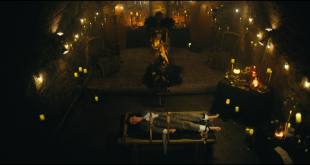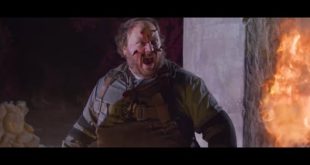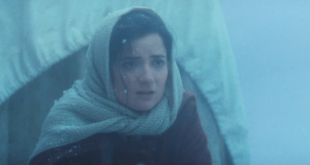
If you’re looking for something cool to do this summer while it’s hot outside and you want to see how the amazing horror film special effects are done, or if you want to learn about makeup, look no further than the special effects class being offered at New York University’s Tisch School of the Arts. The professor, Robert Benevides, spoke with HorrorNews.net regarding his love of horror and sci-fi and his passion for the class that he created and teaches.
Jonathan Stryker: Tell us a little bit about yourself, your background, and how you became a professor of make-up/special effects.
Robert Benevides: I’ve always loved horror and Halloween. October was a big time of the year for me. I used to decorate my parent’s house every year. I started teaching myself how to make masks. I was a fan of horror masks, Halloween masks, etc., and I used to see them all the time in the drugstores and I really wanted to make my own. I used to look over all of the magazines of the time: Fangoria, Cinefantastique, Starlog, and Famous Monsters of Filmland and Cinemagic. I loved reading them because not having any special effects or makeup classes at the time, I learned a lot just by doing it. It also got me to think for myself. I saw Star Wars when I was ten years-old and that’s what really got me heavily into creatures and other kinds of visual effects but I still focused on makeup.

Robert Benevides (he’s the one on the left)
JS: What were some of the first horror films you recall seeing?
RB: Night of the Living Dead, Dawn of the Dead, and Friday the 13th. These were the big gory movies of the 1960’s, 1970’s and 1980’s. That was really the era when they began showing the gore in the violence on screen. I found myself fascinated by it and wondered how you could actually go about doing things like that in the real world. Directors were no longer cutting away from the brutal action, they were actually showing it. Alien and John Carpenter’s version of The Thing were the two movies that were very instrumental in getting me into the art of makeup effects.
JS: So you followed the careers of Tom Savini, Rob Bottin, Dick Smith, and the like?
RB: Dick Smith accepted me in his advanced Make Up Course in 1990. He was actually the one who recommended me to my former boss at the Metropolitan Opera. Dick Smith was a huge influence on my life. Also Rick Baker who had worked on Star Wars. I actually bought Tom Savini’s book, which was called Grand Illusions and later on, Bizarro, when I was in high school and that helped me enormously. It had a lot of terrific step-by-step instructions in it.

JS: I think we kind of take things for granted now, with documentaries and the like, being available to us 24/7 on the Internet. It’s easy to forget that thirty-five to forty years ago, you couldn’t just look these things up! You had to be resourceful and to go out and find these things.
RB: Exactly! You can also see a lot of great step-by-step videos on YouTube now. YouTube is sort of a double-edged sword though. It’s both a good thing and a bad thing because anybody can post to it!
JS: I agree. I’ve seen some excellent videos on getting yourself out of a jam with a computer, such as problems with Windows 10 or Microsoft Office and they’re almost professional quality. But then I’ve also seen videos that illustrate how to disassemble a laptop and the camera work is so shaky you’d think it was shot by a five year-old.
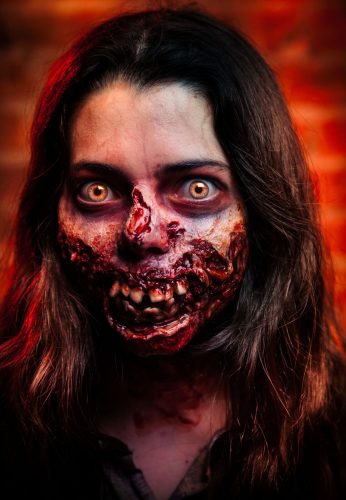
RB: Exactly! See, back in the day, you knew that you were getting your information from an expert. The info was coming from a legitimate source, somebody whom you felt knew what they were doing. On the flip side, nowadays I think it’s harder for younger people to kind of figure out what’s good and what’s not because there’s just so much out there. So, it’s just like aesthetically I feel like a lot of the things I see that young people do, they tend to be a little bit sloppy and put their projects together with cheaper materials. Sometimes I feel like if someone is watching one of these YouTube videos, they’re just following them step-by-step and they’re not really going through it and trying to figure it out for themselves. So in that sense, I feel that that kind of changes the way that you nurture your creative brain. But of course, as I said, there is a lot of really great stuff out there on YouTube. People have to really try to learn and certainly look at real things to and compare it to what they’re seeing people do and try to figure out who is doing the things that look the most realistic. I’ve always tried to be very realistic in my work even if it’s a creature or whatever it is I’m making. I’ve always tried to base it somewhere in reality because I think that the audience will respond to that better.
JS: The courses that you teach at the Tisch School of the Arts in New York City, how did they come to be?
RB: I went to New York University film school and got my degree in film. I had already been doing makeup since high school and I was also makeup on student’s films in college. As far as movies that I’ve worked on, my first feature was Def by Temptation which, by today’s standards, is a pretty cheesy horror movie. (laughs) But it seems to have developed somewhat of a cult following. I got to work on these movies when I was a junior at NYU which was very exciting at the time. I was about twenty years-old when I got that. I also worked at the Metropolitan Opera House for three years doing makeup and I obtained my makeup apprenticeship there. I got into the makeup union because of that. It focused a lot on stage makeup which was something I’d never done before, and that was a very good way to expand my horizons a little bit. I also did some independent films after that. I worked on I Shot Andy Warhol, Clean, Shaven, Fever with Henry Thomas, No Way Home with Tim Roth, Frogs for Snakes, and also worked on the remake of The Manchurian Candidate. Manchurian was the last big movie that I did because at the time I was doing that, I was hired to teach full-time at Tisch. But as far as creating my classes that I teach, I did those after I graduated. Since I never had classes like that, I felt that it would be a great opportunity to propose them which is what I did. I spent the next ten summers teaching as an adjunct. That was before I was hired full-time. In actuality, I’ve been teaching for 25 years, but for the last 15 years as full-time. So, I created my class at NYU.

JS: Who would be the ideal candidate to take your class?
RB: Well, I think that there are a lot of different people who can benefit from it. First of all, makeup artists who might just do regular makeup, straight makeup, and beauty makeup and things like that. They may want to branch out and learn some special effects techniques. At that point, they already have the artistic background and makeup experience. I feel that this is a perfect class for someone in that position. And now, since I have this summer class coming up beginning in the middle of June, this is the time of the year when a person in that position would benefit from this type class. Since I teach in open arts, anyone can take the class at NYU. That means that they don’t even have to be a film student in order to take it. So, I get a lot of different people from different backgrounds who might not have done art for a long time but they may want to give it a shot again. I believe that the television show Face Off was helpful in getting a lot of information out there about makeup effects and bringing it more into the mainstream. I find that people are really happy with the class as it’s the type of class where all of the work is done in the classroom. This really gives you an opportunity to put down the computer, the tablet, and the cell phone and all the other distractions and really work with your hands again. That’s something that we have almost forgotten about! It’s a great thing to be able to do something new in the real world, not just in the digital domain. It’s a really cool thing, and students really appreciate that. They like that aspect of it, that they’re actually using their hands. By doing this, they sometimes discover that they have a talent they didn’t even know that that they had. People may find that they would like to pursue a different field and change careers completely or maybe they just want to rethink it and continue on doing it. So it’s great, for beginners. I tell people all the time that even if they feel that they don’t possess artistic talent, they can still take the class. The way that I teach, I basically break everything down into steps and by doing that it makes everything a lot simpler. If you break it down into steps I feel that it’s not as daunting a task for people to actually make something, because they really see all of the steps that go into it and how you keep building upon those steps and techniques that you learn until you get to a certain place where you start to feel comfortable and more creative about creating your own stuff. I come up with all of the projects that the students make, but there is still creativity that comes from the student within each project that they make.


JS: Sure, it’s a way of demystifying the process.
RB: Right!
JS: After someone takes your first course, what is the next step?
RB: During the summertime we only offer my first course, which is Special Effects I. However, I do have a Special Effects II class which builds upon the skills that a student learns from Special Effects I. They get to know me as a teacher, and by the time they take the second course, we already have a rapport and I know their personalities and their strengths. At that point they can jump right in and work on projects that are a little bit more advanced than what we did in the first class. They take a little bit more time and therefore we have fewer projects in the second class since there are more steps involved. Whereas in the first class, we do a lot of what I like to call “out of kit” effects which consists of the replication of bruises, wounds, cuts and burns. These are basically foundational makeup effects. You can do these right out of your kit. If you have all the right supplies in your kit, which you will since I give them to you, you can do these right “out of the box” so to speak. We use pictures of real-life injuries and use those as a guide and the foundational basis for doing the special effects. In both classes I put together the kit personally which will have everything that the student will need for the course. The students don’t have to bring anything, except themselves! At the end of the class, they get to keep the kit. They will have the latest makeup materials in it. It’s not like a student makeup kit, because you can go to a makeup company and buy a student makeup kit but it’s going to be a very simplified version of what I give my students. I really pick and choose very special items to put in the student’s kits. This is all based on what I feel is the current trend or something that’s important for someone to know right when they’re starting out. We work with a lot of different silicones because silicone is the latest material that’s used in the industry. I go out of my way to update my class in terms of materials as newer ones become available. I feel that as an artist you never stop learning. I still continue to learn as I love learning new things. I’m always on the lookout for new materials, experimenting with them and seeing how I can incorporate them into the class.
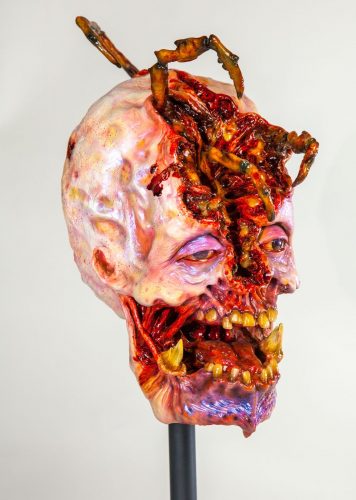
That keeps it very fresh for me. Like anything else, if you do something for a long time you can get very stale and bored after a while, and that’s not fair to the student’s you’re teaching. I will change a project and I will also change the materials as I get new ideas. It’s a really fun class. The final exam that we give is wherein the student takes everything that they’ve learned and makes a final maquette. A maquette is a small sculpture that you fabricate to show a producer or a director any kinds of designs that you have before you go ahead and do the full-scale version of whatever it is you’re creating. For example, during this past semester we did Star Trek versus Star Wars aliens. I had students pull those two titles out of a hat and then depending upon which title they pulled, they would then create an original creation that could be a possible makeup concept that would live and exist in either the Star Trek or Star Wars universe. Basically, they would get a foam bust, a half-scale bust that looks like a life-cast when you cast a performer’s head. We use a self-hardening clay and we build up in layers over different classes. They learn about anatomy and sculpture techniques. All kinds of textures and paint effects that you can kind of bring the character to life. So, that’s our final project. We’re also going to do this frozen corpse makeup to replicate what someone would look like if they were stranded out in the wilderness and froze to death, with icicles hanging off them. We create the icicles with silicone and teach them how to do frosted, kind of snowy effects. I try to orient the class so that if someone does want to continue with makeup or if they are a makeup artist they will be able to use these techniques that they learned in the class out there in the real world right away, on a job after that. Everything that the student in my class is transferable to a company in the real world. There’s no point in putting a student through in-class exercises that cannot be used on a future job.

JS: You’re also an accomplished photographer whose work has been published in the Pretty in Punk book. Do your photographic skills come into play in class?
RB: are were absolutely. I photograph all the students work and upload the images to a cloud-based, file hosting service like Dropbox or equivalent. This way, my students have a nice portfolio of their work when they are finished.
JS: if someone has questions for you prior to taking this class, how can they contact you?
RB: The best method andis to contact my wife, Alyce Benevides, at her email address, which is alyce.benevides@nyu.edu and she can direct potential students to the proper channels regarding questions and registration for the class. Basically, if someone is not currently an NYU student, they first have to register as a student and pay a $25 registration fee. This will give you what’s known as an “N-number”. After you receive this N-number, you can then proceed and take a look at the course listings and take whatever class that you want. That’s for non-NYU students. If they are already registered and attending NYU currently, then they will already know what to do as far as looking up and signing up for the class. I want to also reiterate that no previous art experience is required for the class. So, come on down and let’s have a fun summer!
Please note that non-NYU students/people will have to apply as “visiting students” via the Office of University Programs in order to take a summer class at NYU. Once you apply and are admitted, you will be considered matriculating and will be able to register for coursework for academic credit. It is only after you are admitted, deposited and issued an “N-number” that you can freely use the “Albert Portal” and register for classes. University Programs is then considered for all intents and purposes your home department for the duration of your summer stay.
FMTV-UT 1083 Special Effects Make Up I
This course explores the art of special effects make-up in an introductory level hands-on workshop designed for students wishing to develop techniques they can use on their own productions, experienced beauty make-up artists seeking new effects techniques, art majors & photographers wishing to enhance skills to be applied toward their fine art projects and anyone who has ever watched a film and wondered “how’d they do that?” Topics include “out-of-kit” makeup effects including cuts, bruises, black eyes, scabs, scars, wounds, burns, and frost bite; skin safe molding procedures; casting and painting silicone replica props; and designing and creating a 1:2 scale character maquette. Anatomical reference and safety using materials is also addressed. University Bursar will assess a lab fee for this course. Students receive their own specially designed makeup kit with all materials necessary to complete all in-class assignments. No artistic background required. Course counts as a CRAFT COURSE. COURSE SUBJECT TO DEPARTMENTAL FEES
Summer 2018
Session 1: meets for 3 weeks, 4Xs/week (T,W,TH,F: 6/12-6/29)
FMTV-UT 1083 | 3 units | Class#: 6475 | Session: 3W2 06/12/2018 – 06/29/2018 | Section: 001
Class Status: Open | Grading: Ugrd Tisch Graded | Instruction Mode: In-Person
Course Location: Washington Square | Component: Studio
06/11/2018 – 07/01/2018 Tue,Wed,Thu,Fri 1.00 PM – 4.00 PM at 721B 711 with Benevides, Robert
Notes: Course Repeatable for Credit.
Session 2: meets for 6 weeks, 2Xs/week (T,TH: 7/3-8/9)
FMTV-UT 1083 | 3 units | Class#: 4206 | Session: 6W2 07/03/2018 – 08/09/2018 | Section: 002
Class Status: Open | Grading: Ugrd Tisch Graded | Instruction Mode: In-Person
Course Location: Washington Square | Component: Studio
07/02/2018 – 08/12/2018 Tue,Thu 1.00 PM – 4.15 PM at 721B 711 with Benevides, Robert
Notes: Course Repeatable for Credit. OPEN TO ALL STUDENTS. Tisch Film & TV majors and NYU non-majors may register via Albert. Visiting students (non-NYU) can find enrollment information at http://specialprograms.tisch.nyu.edu/page/sumnyc.html. Lab fee: $433
FMTV-UT 1083 | 3 units | Class#: 4297 | Session: 6W2 07/03/2018 – 08/09/2018 | Section: 060
Class Status: Open | Grading: Ugrd Tisch Graded | Instruction Mode: In-Person
Course Location: Washington Square | Component: Studio
07/02/2018 – 08/12/2018 Tue,Thu 1.00 PM – 4.15 PM at 721B 711 with Benevides, Robert
Notes: Course Repeatable for Credit. Open to pre-college students only. Lab fee: $433

 Horror News | HNN Official Site | Horror Movies,Trailers, Reviews
Horror News | HNN Official Site | Horror Movies,Trailers, Reviews

